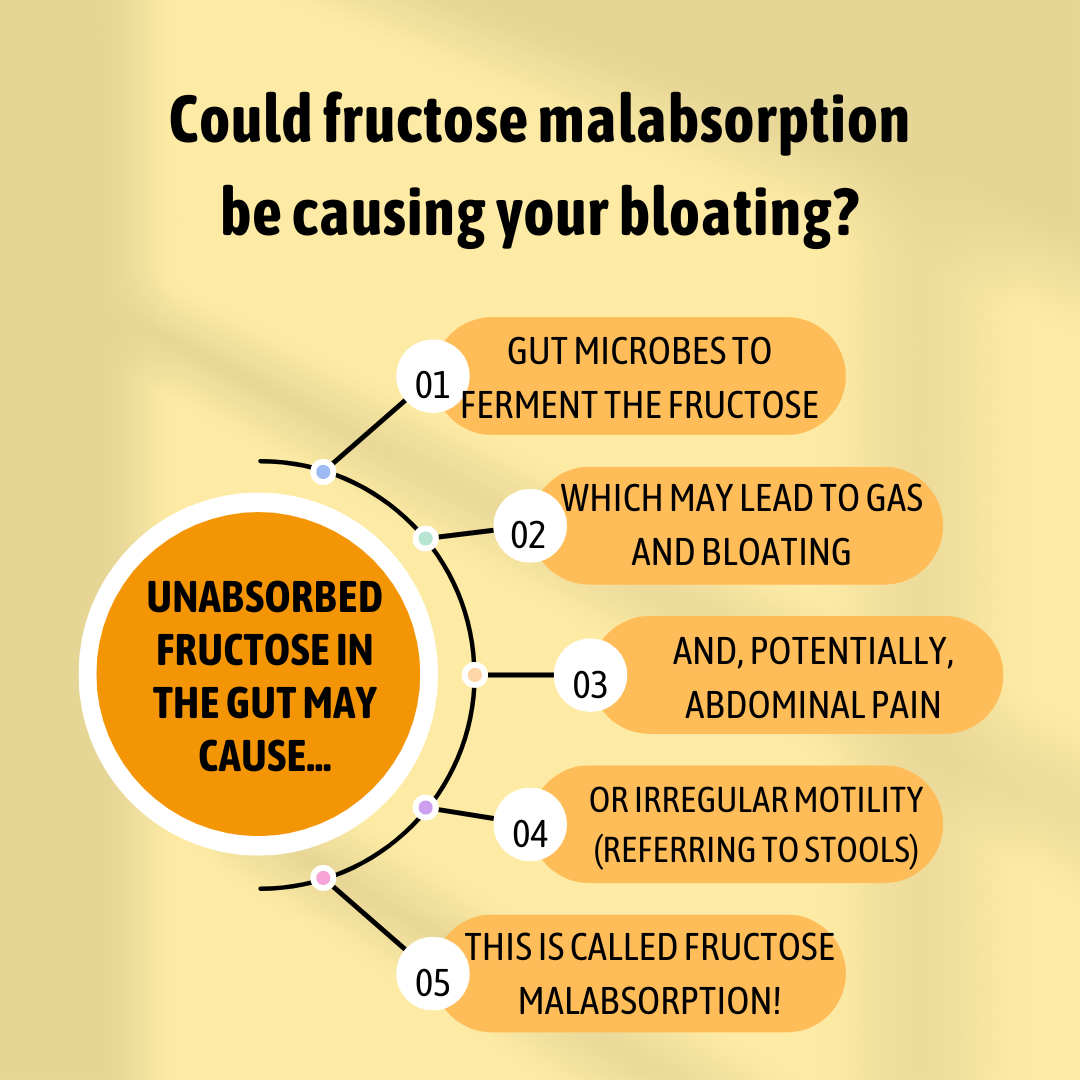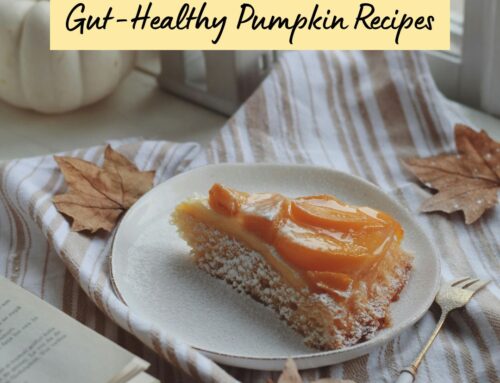It seems like there are an infinite number of potential culprits for bloating. “Is it something I’m eating? Is it something I’m not eating? What about a medical condition, like a parasite or SIBO? Could it be plain old IBS?”
We know that gut health journeys can be convoluted and that finding the cause of your symptoms may take some work. But one thing that likely contributes to many people’s gut health symptoms is fructose consumption.
Maybe you’re thinking – fructose? Isn’t that in fruit – which is healthy for us?
Yes, and yes. But in excess, probably not. Let’s examine how monitoring fructose consumption could help alleviate your digestive issues.
About Fructose and a Brief History
Fructose is a type of sugar. There are several types of sugars that we tend to consume, including sucrose (table sugar), glucose (found in starches), fructose (found in lots of fruits and vegetables), maltose, isomaltose… and the list goes on.
Fructose consumption has skyrocketed over the last few decades – for a good reason (1). It tastes great! But there’s a darker side to the ramp-up.
We know you’ve heard a million and one stories about the “evils” of the food industry, but hang in there with us – this may help you with your gut issues.
Food companies began using high fructose corn syrup in the 1970s and 1980s (2). All that means is that they replaced the sugar mix they were using before (which was composed of about 50% sucrose and 50% fructose) with sugar mixes that were higher in fructose. These newer sugar mixes are typically referred to as “high-fructose corn syrup.” After this shift, Americans’ fructose consumption seems to have increased (1).
Scientists argue that there’s an issue with that: our small intestines can process only a certain amount of fructose at a time (3). Fructose seems to be more challenging to digest in excess than other sugars, like glucose.
The body seems to tolerate small portions of fructose, somewhere around 25g at a time, such as what’s found in fruit (3). But here’s the kicker: fructose content in a single fruit is much lower than the amount found in an equal amount of high fructose corn syrup.
Let’s look at a quick example. One medium apple, weighing 169 grams, contains about 10g of fructose (4). On the other hand, About half a cup of high-fructose corn syrup, weighing about 169 grams, contains about 70g of fructose (5). That’s a 7-fold difference – you’d have to eat seven apples to match just half a cup of corn syrup!
Why We Struggle With Fructose
You might be asking – why is it that we struggle to process fructose compared to other sugars?
Ask a chemist, and you may get a long-winded answer about the difference between fructose’s chemical structure and other sugars’ chemical structures. But today, we’ll keep it simple.
In short, the theory goes like this: we have specialized cells in the small intestine designed to absorb fructose. Each person has a limited amount of these cells. Consume too much fructose, and you’ll overwhelm them (7, 8). This leads to too much unabsorbed fructose hanging around in the gut.
Studies show that too much unabsorbed fructose hanging out in the gut can piss off our immune system and gut microbiome and may even perpetuate dysbiosis (6). It can cause nasty symptoms like (7):
- Intense bloating and gas (gut microbes may ferment the fructose)
- Abdominal pain
- Irregular motility
- Nausea
Some people can tolerate fructose better than others. This may be due to the amount of “fructose carrier” cells in their guts. It may also have to do with the status of their microbiome.
It is estimated that about a third of people have what’s referred to as “fructose malabsorption,” meaning they struggle to digest the amount of fructose commonly consumed in a typical Westernized diet (7).
Do you suspect that you have fructose malabsorption? You can find out by limiting your fructose consumption or cutting it altogether. Check out our next blog to learn how.
Tracking Fructose Consumption
Yeah, yeah, we know. No one likes to count calories or ambiguous food facts like fructose. But don’t worry – we’re here to help.
We recommend starting by spending three days consuming 0-10 grams of fructose per meal. Depending on how you feel, you can slowly increase your fructose limit over time.
To be sure you’re consuming less than 10g of fructose per meal, you’ll need to know which foods are high in fructose. iPhone apps like Cronometer are great tools for tracking the fructose in your meals. All you’ll need to do is enter the food item you plan to consume and scroll to the bottom where it says “fructose” to find out how much fructose is in it.
However, knowing which foods are high in fructose in the first place is helpful, so you don’t have to rely on apps.
Let’s take a look at what types of foods are typically high in fructose:
- Soda
- Dried fruit
- High-fructose corn syrup (will be in many processed foods)
- Processed foods that contain added sugar (cereals, granola bars, etc.)
- Sauces that contain added sugar (ketchup, sweetened pasta sauce, etc.)
- Honey and other syrups
- Fruit juices
- High volumes of fruit (try to limit fruit to ½ cup at a time)
- Pastries, ice cream, desserts
Don’t freak out – we see some of our favorite foods here too. Having fructose malabsorption does not mean you need to eliminate these foods forever. You’ll eventually start reincorporating them to discover how much of them you can handle.
Let’s look at a sample 10-day fructose elimination plan.
Round 1: Days 1-3: 0-10g of fructose per meal
- Pick fructose-free carbohydrates like rice and potatoes
- Watch for hidden fructose in nuts
Round 2: Days 4-6: 10-20g of fructose per meal
- Begin to incorporate small portions of fruit and nuts that contain fructose
- Try a small portion of a dessert, such as ½ cup of vanilla ice cream (which has less than 15g of sugar)
Round 3: Days 7-10: 20-30g of fructose per meal
- Evaluate how your body reacts to moderate portions of fructose, such as smoothies, oatmeal with fruit, etc.
Round 4: Days 11-14: 30+g of fructose per meal
- This is where you’ll find out if you’re honestly dealing with fructose malabsorption. Test your body’s limits – give it lots of fructose, and see how it reacts.
If you experience gastrointestinal distress during all four rounds, you likely have a different issue – fructose malabsorption may not be your answer.
On the other hand, if you feel healthy during rounds 1 and 2 but not during rounds 3 or 4, you may struggle with fructose malabsorption.
Continue experimenting to find out how much fructose is right for you. Tag us in your low-fructose meals on Instagram @igynutrition. Thanks, and see you next time!
References
https://academic.oup.com/jn/article/139/6/1228S/4670461
https://pubmed.ncbi.nlm.nih.gov/19064536/#:~:text=High%2Dfructose%20corn%20syrup%20(HFCS,beverage%20industry%20in%20the%201970s.
https://www.ncbi.nlm.nih.gov/pmc/articles/PMC1994910/#:~:text=Healthy%20subjects%20have%20the%20capacity,and%20intolerance%20with%2050g%20fructose.
https://fdc.nal.usda.gov/fdc-app.html#/
https://www.nutritionvalue.org/Syrups%2C_high-fructose%2C_corn_nutritional_value.html?size=100+g
https://www.ncbi.nlm.nih.gov/pmc/articles/PMC3471321/#:~:text=Unabsorbed%20fructose%20reaching%20the%20colon,%2C%20flatulence%2C%20and%20loose%20stools.
https://www.foodintol.com/fructose-intolerance/fructose-malabsorption
https://www.ncbi.nlm.nih.gov/pmc/articles/PMC6457363/




